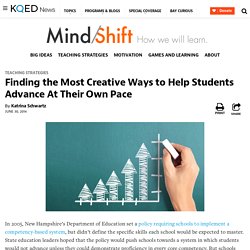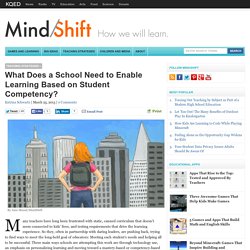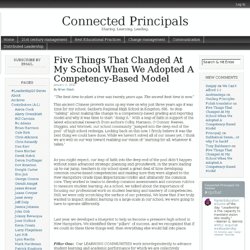Competency Based Learning
> Kenpeterson
> Ed 2.1 Pedagogy
Finding the Most Creative Ways to Help Students Advance At Their Own Pace. In 2005, New Hampshire’s Department of Education set a policy requiring schools to implement a competency-based system, but didn’t define the specific skills each school would be expected to master.

State education leaders hoped that the policy would push schools towards a system in which students would not advance unless they could demonstrate proficiency in every core competency. But schools across the state have interpreted the directive in very different ways and set those competencies both broadly and narrowly. “There wasn’t any training nor was there funding for it,” said Ryan Kaplan, Principal of Windham High School in New Hampshire.” Every school had to figure it out on their own.” Windham is in its fifth year of existence and is still working for official accreditation from the state. The question of student pace — the main feature of a competency-based system — has not been the most important to Windham teachers and administrators. Bethany Bernasconi agrees.
Going All In: How to Make Competency-Based Learning Work. To Break the Mold, Is Competency Learning the Key?
Ask an educator about what it’s like teaching a room full of students, and you’ll likely hear a similar refrain: No two kids learn the same way or grasp concepts at the exact same time.As a result, educators often say they resort to “teaching to the middle.”

More schools are starting to question whether traditional age-based classrooms are the best way to go, and to change the dynamic of teaching to the middle, they’re experimenting with competency-based learning, a system that moves kids along at different paces once they’ve shown they can grasp a key concept of a unit. Kim Carter, executive director of QED Foundation, is a big supporter of competency-based learning. “The choice is, do we want an education system that’s obsolete or do we want a system that is valued and creates value,” Carter said. The foundation offers training, coaching and consulting that focuses on student agency, as well as communities of collaboration both inside and outside school. Katrina Schwartz. What Does a School Need to Enable Learning Based on Student Competency?
By Jane Mount/MindShift Many teachers have long been frustrated with static, canned curriculum that doesn’t seem connected to kids’ lives, and testing requirements that drive the learning experience.

So they, often in partnership with daring leaders, are pushing back, trying to find ways to meet the long-held goal of educators: Meeting each student’s needs and helping all to be successful. Three main ways schools are attempting this work are through technology use, an emphasis on personalizing learning and moving toward a mastery-based or competency-based evaluation system. While not all the same, these approaches share some commonalities and require significant structural changes to the education system if they are to be implemented well. The report defines personalized learning as “tailor[ing] learning to students’ strengths, needs, interests and experiences.”
Competency-Based Education Is Working. Report: Federal Rules Impede Competency-Based Learning. Big Ideas Culture Teaching Strategies Getty Images Competency-based learning, which allows students to progress at their own pace after they’ve shown mastery of a subject, rather than by their age, is quickly gaining momentum.

Already, a few states like New Hampshire, Maine, and Oregon are moving towards implementing competency-based learning models throughout the entire state. What’s more, 40 states have at least district experimenting with the model. But despite this growth, its proponents say federal policies for accountability and assessment are holding the movement back. KnowledgeWorks, an organization that supports three education-focused initiatives — New Tech Network, EDWorks and Strive — recently released a report highlighting the pain points between federal policy and a competency-based system.
“The greatest conflict stems from disconnect with the work on the ground and federal accountability and assessment systems,” the report states. Related. Going All In: How to Make Competency-Based Learning Work. Getty Images New Hampshire is the first state to change its education policies to credit high school students — and soon elementary and middle school students, too — for progressing based on what they’ve mastered, not the number of hours they spend in school.

Known as a competency-based system, the idea is to define the core skills and concepts students should master and only move them forward once they’ve achieved mastery of every competency rather than their “seat time.” In traditional schools, students progress if their average grade is high enough, which may leave room for holes in their understanding of concepts they’ll need in future classes. In the most alternative application of a competency-based system, age-based grade levels would disappear and students would move through concepts at their own pace, regardless of age or grade. “What we saw really lacking was the core concept that students would be advancing upon mastery,” Freeland said.
Finding the Most Creative Ways to Help Students Advance At Their Own Pace. In 2005, New Hampshire’s Department of Education set a policy requiring schools to implement a competency-based system, but didn’t define the specific skills each school would be expected to master.

State education leaders hoped that the policy would push schools towards a system in which students would not advance unless they could demonstrate proficiency in every core competency. But schools across the state have interpreted the directive in very different ways and set those competencies both broadly and narrowly. “There wasn’t any training nor was there funding for it,” said Ryan Kaplan, Principal of Windham High School in New Hampshire.”
Every school had to figure it out on their own.” Windham is in its fifth year of existence and is still working for official accreditation from the state.
Going All In: How to Make Competency-Based Learning Work. Five Things That Changed At My School When We Adopted A Competency-Based Model. “The best time to plant a tree was twenty years ago.

The second best time is now.” This ancient Chinese proverb sums up my view on why just three years ago it was time for my school, Sanborn Regional High School in Kingston, NH, to stop “talking” about making the change to a competency-based grading and reporting model and why it was time to start “doing it.” With a leap of faith in support of the latest educational research from authors Colby, Marzano, O’Connor, Reeves, Stiggins, and Wormeli, our school community “jumped into the deep end of the pool” of high school redesign. Looking back on this now, I firmly believe it was the best thing we could have done. While we haven’t solved all of our issues yet, I think we are well on our way toward realizing our vision of “learning for all, whatever it takes.” As you might expect, our leap of faith into the deep end of the pool didn’t happen without some advanced strategic planning and groundwork. 1. 2. 3. 4. 5.







